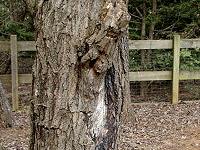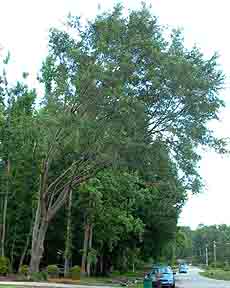“We abuse the land because we regard it as a commodity belonging to us. When we see land as a community to which we belong, we may begin to use it with love and respect.”
Rene Dubos
Trees are essential. They supply us with oxygen to breathe, keep our air and water clean, and sustain life for all living organisms. The earth is home to over 3 trillion trees, but sadly, due to deforestation, we lose 15 billion every year.
Each of us can have a role in taking care of the community and protecting trees. And we can begin with the ones right on our property!
Like us, trees can get sick. It’s important to keep track of the ones on your property and know the signs of disease, which can threaten the safety of you and your family and lead to you having to completely remove them. With 15 billion being cut down each year, full extraction should be the last resort unless the situation puts you or anyone else in danger.
So, how do you know whether your tree is sick? And what can you do to treat it? This article will go over some signs to look out for, three common diseases, and what steps you can take to keep your landscape healthy.
How Do I Know My Tree Is Diseased?
Learn about some common tree diseases and how you can spot, prevent, and treat them. Having at least a basic understanding of the signs of disease can help you prevent injury to yourself and your family and property damage from fallen branches and trees.
We have listed three of the most common infections many property owners deal with.
The 3 Most Common Tree Diseases In Maryland
The Infamous Anthracnose
Anthracnose is one of the most common and harmful diseases that can kill trees if not addressed properly. Flowering Dogwood and Sycamore are two species that are particularly at risk of this infection. Anthracnose is caused by several types of fungi such as Colletotrichum, Kabatiella, Elsinoe, and Apiognomonia.
This disease mostly affects the stems and leaves and over time can cause defoliation, cankers, withering leaves, and twig blight which leads to witch’s broom. Anthracnose is particularly worse when there is humidity.
Bacterial Leaf Scorch
Bacterial Leaf Scorch affects many species, including White Oak, Red Maple, Sycamore, and Sugar Maple. It is caused by the bacteria Xylella fastidiosa and is spread by spittlebugs and leafhoppers.
This disease can take anywhere from three to eight years to fully develop. The early symptom is early browning of the leaves during the warmer months. Over time, more and more leaves turn brown until the entire tree is brown. The leaves begin to lose the ability to produce chlorophyll and this results in recurring defoliation and dying branches.
Tree Rust
Tree rust affects many species and can dramatically affect the aesthetic appeal of your landscaping if not treated. It is caused by several different types of fungus depending on the species. The most common fungus, however, is M. medusae.
The first sign of rust is discolored spots on the leaves. These spots usually start as white but darken over time. The rust eventually creates bumps on the surface of the affected leaves. If not addressed, this infection could cause defoliation as leaves die and fall, affecting the long-term health of the tree.
Treatment Checklist For Your Trees
Treating & Preventing Anthracnose
Pruning is one of the best ways to prevent the spread of Anthracnose. Pay attention to any twigs and branches that are dying. These should be removed promptly as decaying wood is the perfect host for the deadly fungi. Pruning is best done during the cooler months during the dormant stage and when the fungus is less active.
Another way to prevent Anthracnose is by applying fungicide when the buds first open. Some trees like the Dogwood need ongoing treatment during the entire growing period.
How To Prevent Bacterial Leaf Scorch
Sadly, there is no cure for Bacterial Leaf Scorch. However, the situation is not completely out of your hands! You can take steps to keep your trees healthy and strong so they’re prepared if they ever develop this disease.
If your trees do fall victim to Bacterial Leaf Scorch, you can help them last longer by sanitizing them and pruning any and all branches and limbs that are infected. While pruning, don’t forget to clean your tools and equipment with a bleach solution to avoid spreading the infection!
Feel free to hire a certified arborist to handle the job for you. They will ensure all tools are properly sanitized during the pruning process.
How To Treat Tree Rust
Rust is not as harmful as other diseases like Anthracnose. However, it’s important to properly treat it to prevent it from spreading. The primary way of treating this is by removing all infected leaves and applying fungicide to prevent the disease from returning. A certified arborist will get the job done for you so you don’t have to worry about proper application techniques.
Are you enjoying this post so far? Our blog is an extensive resource of tree care information for gardeners, arborists, and curious readers alike! What other gems will you read on our blog? Find out in the video below!
Removal May Be Necessary When…
While full removal should be the last resort, it is sometimes necessary when there are severe problems that could put you, your property, and others in danger. Here are four signs to look out for when deciding on full extraction:
- There is severe trunk damage or rot
- The trunk is hollow
- There are large dead branches
- Sudden leaning
Severe Trunk Damage & Rot
In serious cases, these wounds can harm the layer of the trunk that is responsible for carrying water and other nutrients throughout the tree! Here is a good way to measure the seriousness of the wounds: if more than 25% of the trunk’s circumference is damaged, then the tree will most likely not heal and needs to be extracted. However, even when less than 25% is damaged, there is still a chance that full removal will be needed later on. For this reason, it’s important that you regularly inspect your trees. Mike Timber’s Tree Removal would be happy to schedule routine visits for you.
A Hollow Trunk
Another common sign that you need full removal is a hollow trunk. While it is true that hollow trees can live a long time since the tissue that sustains life is on the outside, if enough of the trunk is hollow and/or rotten, it is weak and won’t stand long. If more than 30% of the trunk is hollow, then it’s probably best to hire a licensed arborist for full extraction.
Beware Of Large Dead Branches!
There are several factors to consider with large, dead branches and whether removal is the best option. Dying limbs can be the result of disease, fungus, insects, or they could simply reveal the tree is self-thinning and trying to preserve itself. If more than a quarter of the branches are dead or dying, you and your property may be in danger and full removal is necessary.
If you see several large, dead branches on only one side of the tree, this could reveal root or trunk damage. It’s best to hire a certified tree surgeon to inspect the situation and help you decide whether only certain limbs or the entire tree needs to be removed.
Sudden Leaning
Not all trees that lean are dangerous. Species like Oak with stronger wood can remain standing and do not always need to be removed. However, it’s important that you carefully inspect any leaning tree on your property. Leaning can be a sign of root damage and rotting, which can pose a safety hazard if your home or other property is in the fell path. Have an experienced arborist investigate the situation.
Mike Timber’s Tree Removal in Davidsonville Maryland would be happy to visit your home and ensure your property is in safe condition. Give them a call today!
Planting new trees on your property? Check out our next article “Tree Care Tips For Marylanders“!


